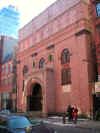 |
New York
Architecture Images-Lower East Side
Congregation Shaarai Shomoyim (First Roumanian
American Congregation) |
|
architect |
unknown |
|
location |
83 Rivington Street |
|
date |
1857, demolished 2007 |
|
style |
Romanesque Revival |
|
construction |
red brick |
|
type |
Synagogue |
|
|
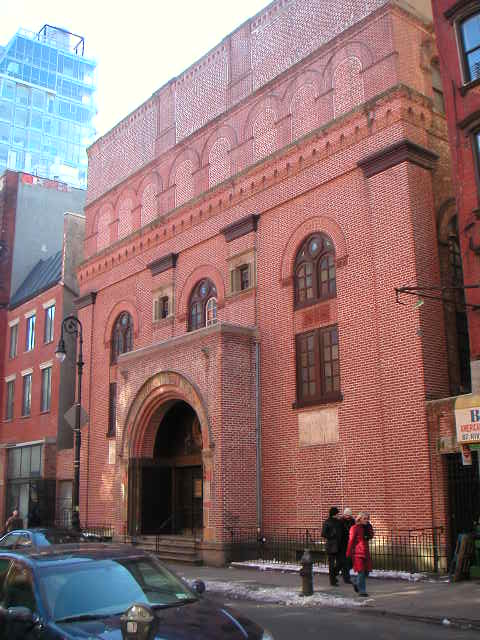 |
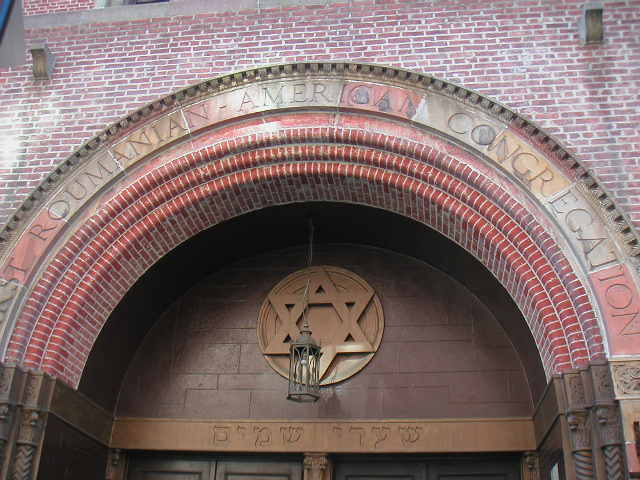 |
|
|
images |
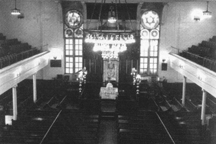 |
|
|
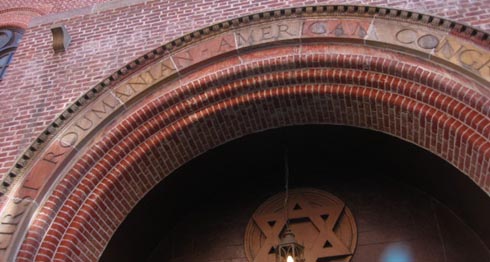 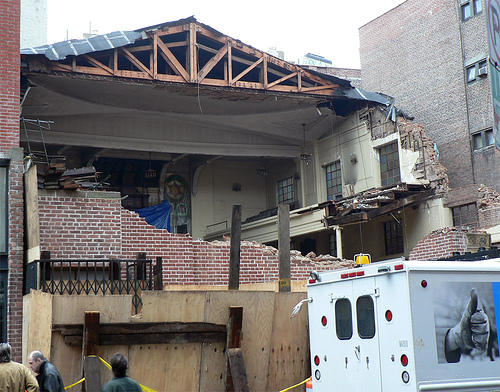 |
| The demolition. | |
.jpg) .jpg) |
|
.jpg) .jpg) |
|
|
First
Roumanian-American Congregation,
Shaarey Shamoyim (Gates of Heaven). This 2,000-seat sanctuary was originally built around 1857 as the German Evangelical Church. Designed to convert Jews, it was bought in 1864 by Shaaray Hashomayim, New York's oldest Orthodox German-Jewish congregation. It reverted to a church in 1890, when a Methodist mission society moved the Allen Street Memorial Church here. Finally the current congregation bought it in 1902. Recognized as a center for cantorial music, the synagogue was known as "the Cantor’s Carnegie Hall." It's been a synagogue ever since, though no longer primarily Romanian. Led by Rabbi Jacob Spiegel and offering daily services, the present congregation draws its members from the local Jewish community of residents and merchants. |
|
|
First American-Roumanian congregation (also First Roumanian-American
congregation, Congregation Shaarai Shomoyim, or the Roumanishe Shul),
was an Orthodox synagogue located at 89-93 Rivington Street in
Manhattan, New York, on the Lower East Side. Origins The Romanesque Revival structure was originally built around 1857 as the German Evangelical Church, which was designed to convert Jews. It was bought in 1864 by Shaaray Hashomayim, New York's oldest Orthodox German-Jewish congregation. In 1890 it reverted back to a church when a Methodist mission society moved the Allen Street Memorial Church, though in 1902, it was finally bought by Congregation Shaarai Shomoyim. Congregants who as little as $10 towards the purchase were honored with having their names engraved on four marble slabs in the stairway to the main sanctuary (the most generous gift being $500, at a time when $10 was two-weeks pay). Glory years The synagogue's sanctuary, seating approximately 1,800, contained multiple seating levels to separate men from women and, with such a lofted ceiling, it became renowned for its acoustics. Known as "the Cantor's Carnegie Hall," the synagogue became a center for cantorial music, and many of the greatest cantors of the 20th century led services there. Yossele Rosenblatt and Moshe Koussevitzky began their American careers there, and Moishe Oysher "the greatest of all popularizers of cantorial singing", was a cantor there as well. Jan Peerce and Richard Tucker were also cantors there before becoming famous opera singers. Choir members included Red Buttons and Eddie Cantor, and George Burns was also a member. Decline With the dissipation of the Jewish population out of the Lower East Side during the latter half of the 20th century, the synagogue's constituency dwindled. By 1996, the membership was down to around two dozen, and the synagogue's leader, Rabbi Jacob Spiegel began holding services in the small social hall in the basement, as the main sanctuary had become too expensive to maintain. In 1998 the synagogue building was listed in the National Register of Historic Places. After suffering a heart attack in 2001, Spiegel died, leaving charge of the synagogue to the youngest of his three sons, Rabbi Shmuel Spiegel.[7] In June of 2003 the corner of Rivington Street and Ludlow Street near the synagogue location, and the stretch of Rivington in front of the synagogue, was co-named "Rabbi Yaakov Spiegel Way."[9] At the time of Jacob Spiegel's death, the roof had long been in bad shape, and in 2001 was threatening to collapse. In December, 2001, Shmuel Speigel managed to raise $25,000 for emergency repairs,[2] but by 2004 the regular membership still hovered around 40.[2] Collapse In January of 2006, the roof of the synagogue caved in, severely damaging the main sanctuary. No one was injured, since services had long since been held in the basement. Because the synagogue had never been registered as a historic landmark, it was thereafter demolished in March 2006. The destruction of the synagogue subsequently generated widespread criticism among conservationists. Peg Breen, president of the New York Landmarks Conservancy said congregational leaders "had refused offers of help, including one of up to $10,000 from the conservancy and the National Trust for Historic Preservation. The money would have been designated for engineering work to determine whether the roof could be replaced." Holly Kaye, a consultant to the Lower East Side Conservancy, said that in 1997 the New York State Office of Parks, Recreation and Historic Preservation had made an offer of $280,000 to "help shore up the roof, which was already at risk of collapse then," but that the congregation, under the leadership of Yaakov Spiegel, had also rejected that offer. According to Shmuel Spiegel, however, the repairs required were so extensive that the congregation could not have made them even with this financial assistance.[10] Film appearance The synagogue can be seen in the motion picture I Am Josh Polonski's Brother by Raphael Nadjari, shot in 2000 in New York City and starring Richard Edson, and Rabbi Spiegel as himself. Notes ^ a b Joselit, Jenna Weissman. "THE WONDERS OF AMERICA: Mourning the Loss of a Lower East Side Jewel", The Forward, April 14, 2006. ^ a b c "Rivington synagogue hangs on, hoping for a revival", The Villager, Volume 73, Number 46, March 17 -23, 2004. ^ a b Jacobs, Andrew. "NEIGHBORHOOD REPORT: LOWER MANHATTAN;Rabbi Sees Hope for His Dwindling Congregation", The New York Times, June 9, 1996. ^ Sanders, Ronald. The Lower East Side: A Guide to Its Jewish Past with 99 New Photographs, Courier Dover Publications, 1979, ISBN 0486238717, p. 36. ^ Lueck, Thomas J. and Moynihan, Colin. "Roof Collapses at Historic Lower Manhattan Synagogue", The New York Times, January 23, 2006. ^ Zakrzewski, Paul. "A Tale Of Two Synagogues", The Jewish Week, March 24, 2006. ^ a b Barry, Dan. "Prayers Rose, a Ceiling Fell, and a Rabbi's Hope Endures", The New York Times, January 25, 2006. ^ WEEKLY LIST OF ACTIONS TAKEN ON PROPERTIES: 3/09/98 THROUGH 3/13/98, National Register of Historic Places. ^ "Late Rivington rabbi gets his way", The Villager, Volume 73, Number 6, June 11-17, 2003. ^ Lueck, Thomas J. "Questions Rise From the Dust of an Old Synagogue", The New York Times, March 7, 2006. References WEEKLY LIST OF ACTIONS TAKEN ON PROPERTIES: 3/09/98 THROUGH 3/13/98, National Register of Historic Places "Late Rivington rabbi gets his way", The Villager, Volume 73, Number 6, June 11-17, 2003. Barry, Dan. "Prayers Rose, a Ceiling Fell, and a Rabbi's Hope Endures", The New York Times, January 25, 2006. Jacobs, Andrew. "NEIGHBORHOOD REPORT: LOWER MANHATTAN;Rabbi Sees Hope for His Dwindling Congregation", The New York Times, June 9, 1996. Joselit, Jenna Weissman. "THE WONDERS OF AMERICA: Mourning the Loss of a Lower East Side Jewel", The Forward, April 14, 2006. Lueck, Thomas J. "Questions Rise From the Dust of an Old Synagogue", The New York Times, March 7, 2006. Lueck, Thomas J. and Moynihan, Colin. "Roof Collapses at Historic Lower Manhattan Synagogue", The New York Times, January 23, 2006. Sanders, Ronald. The Lower East Side: A Guide to Its Jewish Past with 99 New Photographs, Courier Dover Publications, 1979, ISBN 0486238717 "Rivington synagogue hangs on, hoping for a revival", The Villager, Volume 73, Number 46, March 17 -23, 2004. Zakrzewski, Paul. "A Tale Of Two Synagogues", The Jewish Week, March 24, 2006. |
|
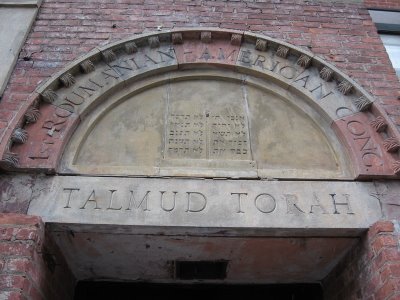 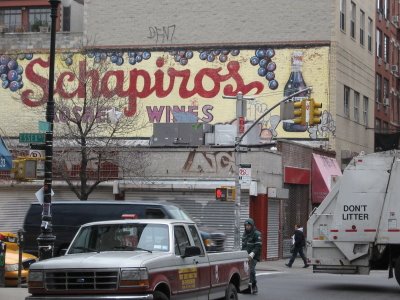 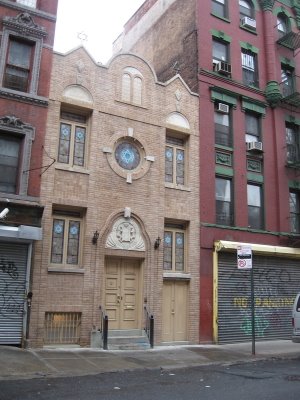 |
|
| I needed to pay my respects to the ruins of the First Roumanian-American Congregation, Shaarey Shamoyim, one of America's most history laden shuls... Cantor Yosele Rosenblatt used to hold sabbath services here.Earlier this year the city inspectors decided that the building was dangerously beyond repair and called the demolition experts. All that remains is this doorway.The population of the Lower East Side is mainly Hispanic and Chinese these days, but there are still a lot of reminders of the time when it was the center of New York's immigrant Jewish community. Shapiro's Incredibly Horrid Sweet Kosher wine has now moved its undrinkable product to a stall inside the nearby Essex St. Market, but their old sign is still outside.Just around the corner is the Kehila Kedoshe Janina Synagogue, the last bastion on earth of the Romaniote Greek language, which is down to maybe four or five elderly speakers. Romaniotes are Greek Jews, which is to say they pre-date Sephardic or Ashkenazic identity, having arrived in Greece after the destruction of the second Temple. According to tradition, the Roman emperor Titus, after capturing Jerusalem in A.D. 70, was transporting Jews to Rome as slaves when his ship was driven by a storm onto the Albanian coast. He allowed the Jews to disembark and thus began a long history that was almost entiurely terminated by the Holocaust. One of the largest Romaniote communities was in Ioanina in Macedonian Greece. Today, this is probably the largest Romaniote institution still in use. | |
|
Villager Volume 75, Number 38 | February 8 -14 2006 Villager photos by Clayton Patterson Outside the First Roumanian-American Congregation, from left, Morris Brenner, Rabbis Shmuel and Ari Spiegel, Council Speaker Christine Quinn and Councilmember Alan Gerson. Roof collapse puts spotlight on crumbling synagogues By Lincoln Anderson City Council Speaker Christine Quinn visited the damaged First Roumanian-American Congregation last Thursday and pledged her support and that of the City Council to help the congregation recover from the disastrous roof collapse that has left the historic building’s future in jeopardy and the congregation homeless. Quinn, who represents Chelsea and part of Greenwich Village, joined Councilmember Alan Gerson, who represents this section of the Lower East Side, and Rabbis Shmuel and Ari Spiegel, in taking a quick look inside the crippled synagogue. They didn’t penetrate too far, but just looked from the threshold. Meanwhile, workers were busy removing the one-third of the roof that didn’t collapse. Quinn said that after reading about the collapse in the newspapers, she wanted to show her support. “This is a very historic and important synagogue,” Quinn told The Villager. “A place that has been in this community since the Civil War. A place that has offered shelter and solace to countless New Yorkers — we saw that after 9/11.” The building, between Ludlow and Orchard Sts., dates from 1857 and was a Protestant church until the synagogue took it over in the 1880s. On 9/11 and in its aftermath, the congregation opened its doors to the community. More plaster coating the pews at the Norfolk St. synagogue, once known as the “Great House of Study.” Asked what specifically the Council can do to help the synagogue, Quinn said, “What exact help they need, they don’t know yet,” she said, adding, “Whatever help they need, we’ll provide.” As for whether the Council might provide funds to help rebuild the synagogue, Quinn said, “It’s not at that point yet.” Gerson later added that there are issues of separation of church and state that would preclude the synagogue getting such funding. Rabbi Shmuel Spiegel, the congregation’s officiating rabbi and one of three brothers who lead the synagogue, said they were first and foremost happy that residents in seven apartments in the building just to the west, 87 Rivington St., were last Thursday allowed to return to their homes, after the synagogue’s western wall was deemed sufficiently stable. Also, a Bangladeshi-run deli next to the synagogue that had been closed since the roof collapse also was allowed to reopen for business last Thursday. The congregation is still working on recovering religious documents and an ornate ark from inside the building. The building is not landmarked, which means there is no roadblock to razing it if the cost and work needed to rebuild it are deemed prohibitive. Rabbi Shmuel later said that Guide One, their insurance company, “is playing hardball. We have an attorney.” After Quinn’s visit to the First Roumanian-American Congregation, the next stop was another nearby synagogue in need of repairs, Beth Hamedrosh Hagodel, at Norfolk and Broome Sts. Built in 1850, first a Baptist and then Methodist church, it was converted in 1885 to an Orthodox Russian Jewish synagogue that became known as “the Great House of Study.” Seven years ago, the synagogue’s tall window above its main entranceway blew out in a windstorm. That misfortune led to the formation of the Lower East Side Conservancy, a group committed to restoring the Lower East Side’s historic synagogues and promoting the area’s Jewish cultural legacy. Holly Kaye of the conservancy, the Rabbis Spiegel, Joel Kaplan of the United Jewish Council of the Lower East Side, Quinn, Gerson and District Leader David Weinberger toured the synagogue’s sanctuary, which is covered with plaster and pieces of ribbing fallen from the ceiling. Downstairs in the basement, a congregation of about 40 continues to meet regularly. Kaye explained that the conservancy plans to turn the sanctuary into a visitors center from which tours of the historic Lower East Side synagogues and other cultural attractions will be led. “It has unbelievable potential,” Quinn said, admiring the sanctuary as they stood among the pews covered with debris. The Norfolk St. visitors center is a $3 million project, with $1 million needed to secure the structure and another $2 million for systems, heating and fixing up the interior. In addition to the visitors center, the space is planned to include a program office for the conservancy, an exhibition space and interactive educational center. The Council last year allocated $500,000 for the project, and Kaye said they want to secure that and hopefully add to it. Kaplan said they also hope to get funding from the Lower Manhattan Development Corporation. So far, the conservancy has raised $2 million for historic sacred sites on the Lower East Side, Kaye told The Villager afterwards. So far, she said, a handful of historic synagogues are showing some signs of rebirth, such as Chasam Sopher on Clinton St., the Sixth St. Synagogue and the Stanton St. Shul. “It’s not what it was like 100 years ago, but…” she said. “Ninety-five percent of all Jews in America came through the Lower East Side,” she noted, stressing the area’s enduring significance to Jews. Now more than ever, there’s an urgent need to preserve the neighborhood’s historic synagogues, Kaye said. “It was fine when we were a forgotten, gritty neighborhood 15 or 20 years ago,” she continued. “But with the rate of development in the neighborhood now….” Within view across Delancey St., a new luxury residential tower called Blue and shaped sort of like an old radio microphone from the 1940s is rising. “This is the fulcrum of really all of them,” Kaye said of Beth Hamedrosh Hagodel. “We probably won’t be able to save all of them. And, unfortunately, the collapse of the roof [of the First Roumanian-American Congregation] serves to show how important it is to preserve them.” Gerson said it’s unclear whether the Rivington St. congregation will repair its roofless building. “I think the congregation will remain on Rivington St.,” he said. “Whether this structure remains or will be rebuilt remains to be seen. “I think we need to convene a meeting on older churches, synagogues, because the city has many of these,” Gerson added. “They remain active, but the congregations don’t have the funding to keep them up.” The meeting would be later this spring, he said. Gerson said the reason why the Norfolk visitors center is eligible for municipal funding is because the space has been taken over by a nonprofit, sectarian institution. Speaking on Sunday night, Rabbi Shmuel said Morris Brenner, who survived Auschwitz as a 9-year-old but lost all his family in the Holocaust, said the devastation of the First Roumanian-American Congregation building reminded him of when the Nazis blew up the synagogue in his town in Poland, but then let them pray on the spot, instead of shooting them like they usually did. “But he said he knows this synagogue will always be there,” Rabbi Shmuel said. |
|
|
links |
Synagogue -
First Roumanian-American Synagogue Roof Collapses At Historic Lower East Side Synagogue Still Standing: The worshippers move out, the ceiling falls in. What to do? The New Old World of the Lower East Side |